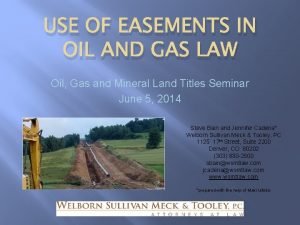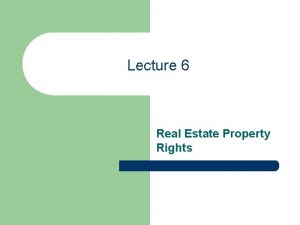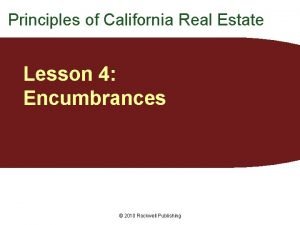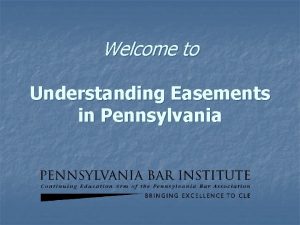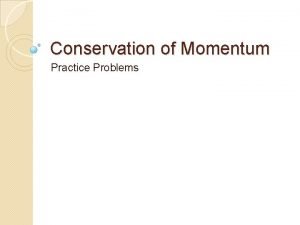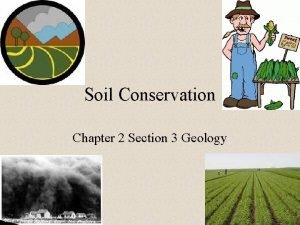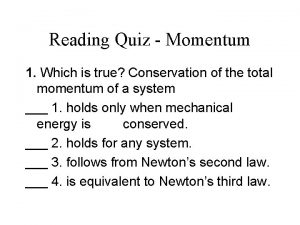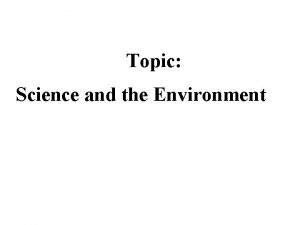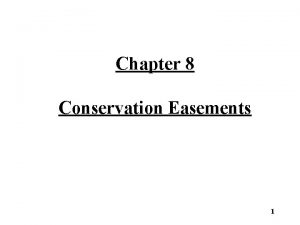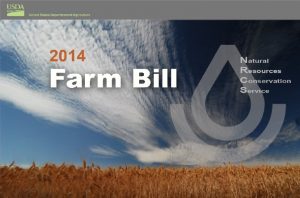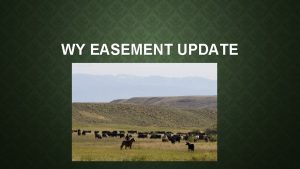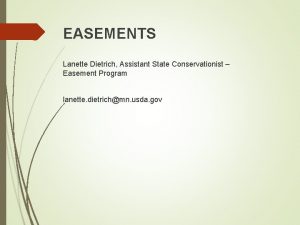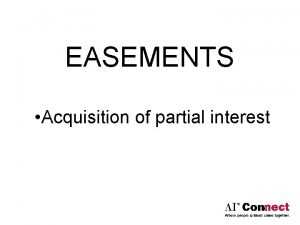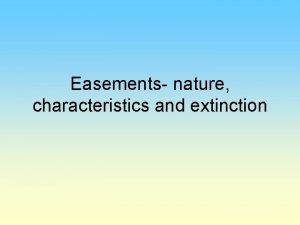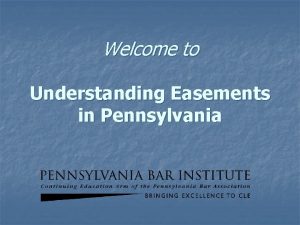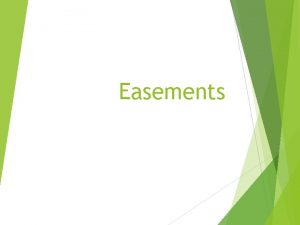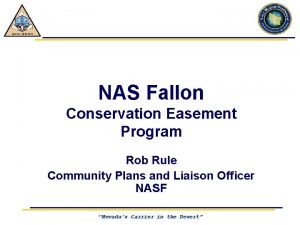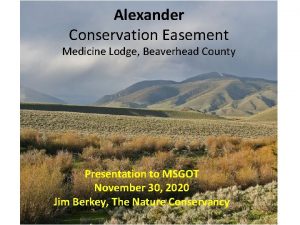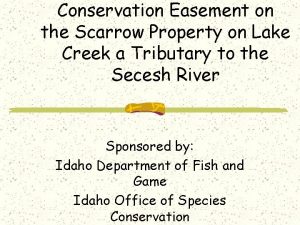CONSERVATION EASEMENTS What is a Conservation Easement n
















- Slides: 16

CONSERVATION EASEMENTS

What is a Conservation Easement? n A conservation easement is a legally binding agreement between a landowner and a governmental agency or conservation group entity that permanently limits uses of the land in order to protect ecological, historic, or scenic resources. Besides possessing a piece of land paying taxes on it, landowners have rights to the land such as the ability to subdivide, build structures, cut trees, mine for minerals, and other rights. A conservation easement allows a landowner to retain ownership while restricting some of those rights in order to protect the property’s conservation values. Easements are custom designed and negotiated to meet the personal and financial needs of the landowner. An easement may cover portions of a property or the entire parcel. The easement will identify the rights the landowner wishes to retain, limit, or forgo.

Why do landowners sell or donate Conservation Easements? n n Landowners sell or donate conservation easements for a variety of reasons. Foremost is a love of their land a strong desire to protect it for their families and future generations. Conservation easements are powerful estate planning tools that provide families the opportunity to plan together for the future of their land. Neighboring landowners who create conservation easements on contiguous properties provide mutual protection against unwanted or unplanned development while sharing the benefits of conserving larger resource areas for wildlife, scenic landscapes, privacy, and prescribe burning. The sale or donation of a conservation easement may provide substantial tax benefits' through the reduction of federal income and estate taxes, and possible property tax relief.

What does a typical Conservation Easement contain? Typical conservation easement between landowners and easement holder will do the following: n n n n Follow the Internal Revenue Code guidelines for establishing conservation easements Specifies how the easement meets the mission of the conservation agency. Establishes the criteria by which the easement meets the test of natural habitat, productive forestry, scenic values, or historically important land area Protect against commercial or residential development of the property Specify that the land may continue to be used in future years, as it is now, for traditional rural uses such as farming, forestry, hunting, wildlife management, etc. Allow for timber harvesting in conformance with “best management” standards and mutually agreeable management plans Specify the maximum number of buildings which may be located on the property in the future Conserve a special animal or plant habitat, wetland feature, or historic resource As a legal agreement, a conservation easement is recorded in county records. Easements are granted in perpetuity, and therefore, all future owners are subject to the easement’s conditions. The role and responsibility of easement holder is to work with the landowner to ensure that the conservation values identified in the easement are protected over time.

What rights does the landowner retain? The landowner retains all property rights except the ones specifically and voluntarily relinquished or restricted by the easement. The landowner continues to own the land can use it in any manner consistent with the easement provisions. Commonly, conservation easements with easement holder allow the owner to continue doing on the land what he or she was doing prior to donating the easement. The owner can sell the land, live on it, or leave it by will. The landowner maintains and manages the property and continues to pay real estate taxes. In essence, while an easement must protect the conservation values on the property, it can be designed in a flexible manner by the landowner to achieve a broad range of personal goals.

What Properties are considered for a conservation easement ? Conservation agencies or groups consider accepting easements that further the mission of the organization and provide strategic conservation values that benefit the general public. Preference is given to those easements that protect land: n n n With important concentrations of natural, historic and or open space resources Facing a high risk of conversion for development Adjacent to existing easements or other protected open space areas Containing a low level of existing development With a low potential for future problems in monitoring, management, liability and enforcement

Must a Conservation Easement allow public access on the property? No. Landowners granting conservation easements choose whether or not to open their property to the public. Public access is only required if the primary conservation value of the property is public recreation or education. Scenic or historic preservation easements require public visibility, but not necessarily access. Most easement holders’ easements do not require public access because they are protecting significant wildlife or plant habitats, open space, or agricultural lands.

Can a Conservation Easement be donated by will? Yes, landowners can specify by will that a conservation easement be placed on their property upon their death. In addition, heirs can place an easement on the property within nine months after the death of a landowner in order to qualify for an estate tax charitable deduction. It is best, however, for landowners to donate conservation easements during their lifetimes, or in their wills, when there is adequate time to work through easement provisions. In all cases, however, it is advised to seek professional counsel regarding estate planning.

What are the costs associated with a Conservation Easement? n n n An attorney to provide legal advice and draft the conservation easement An appraiser to determine the value of the conservation easement which is required if the landowner intends to claim income or estate tax benefits An accountant to determine the income tax implications

Some Florida Conservation Easements Holders US Fish and Wildlife n The State of Florida n Water Management Districts n Nature Conservancy’s n Conservation Trust of Florida n Tall Timbers Fondation n

The Easement Process 1. Inventory and assess biological features and document current conditions of property at time of easement (maps, technical description, et cetera); write Baseline Documentation Report and send draft to landowner 2. Develop Conservation Management Plan utilizing a model document that will outline the proposed measures for protection of the conservation values of the easement - landowner, landowner’s manager, forestry consultant, or consultants 3. Prepare easement specific to the property 4. Negotiate legal easement constraints – purposed easement holder, landowner, and attorneys 5. Submit easement to conservation agency or group for review, comment, and recommendation. 6. Conduct appraisal of property 7. Conduct survey of proposed easement if needed 8. Final easement review by all parties 9. Final easement approved by conservation easement agency or group 10. Signature of easement document by all parties 11. Record easement document, deed, etc. in county court house Monitor condition of easement property annually in perpetuity

Amendment 4 House Bill 7157 Amendment 4 House Bill 7157 created two classes of property tax exemptions. Perpetual : Dedicated in perpetuity, encumbered by an irrevocable conservation easement n Less than Perpetual: Encumbered by an conservation easement of 10 years or more n

Perpetual Conservation Easement Property Tax Exemption New for 2010 Tax Roll House Bill No. 7157 n Exemption for Conservation Dedicated in Perpetuity Form DR-418 C application DR-418 CR renewal Exemption for dedicated in perpetuity and used exclusively for conservation purposes 100% Exemption for dedicated and used only for allowed commercial purposes up to 50% Note: agriculture is an allowed commercial use n Parcels less than 40 contiguous acres are to be sent to the Florida Acquisition and Restoration Council (ARC) for approval

Acquisition and Restoration Council (ARC) n n Florida Acquisition and Restoration Council (ARC) a committee, appointed by the Governor, that selects and ranks conservation acquisition projects, reviews land management issues and provides input to the Governor and the Board of Trustees of the Internal Improvement Trust Fund. This committee will approve or deny all Perpetual Conservation Easements Property Tax exemptions of less than 40 contiguous acres.

Land Used For Conservation Purposes Assessment 10 Years or More, Less than Perpetual Application for the Classification Use (value in use) assessment for land use for conservation purposes for 10 years or more that meets the requirements of the conservation easement in section 704. 06 From DR-482 C application DR-482 CR renewal

Special Thanks Tall Timber Research Station and Land Conservancy Tallahassee Florida n Conservation Trust for Florida Micanopy Florida n
 Dominant and servient easements
Dominant and servient easements Dominant and servient easements
Dominant and servient easements Partial interest
Partial interest General lien vs specific lien
General lien vs specific lien Affirmative easement
Affirmative easement Servient tenement
Servient tenement Non possessory estate
Non possessory estate Conservation of momentum practice problems
Conservation of momentum practice problems Environment management tool
Environment management tool Conservation plowing definition
Conservation plowing definition Law of conservation of mass
Law of conservation of mass Conservation of momentum quiz
Conservation of momentum quiz First law of energy conservation
First law of energy conservation Pragmatic utilitarian conservation
Pragmatic utilitarian conservation Mass conservation
Mass conservation Unit of angular momentum
Unit of angular momentum Ex situ plant conservation
Ex situ plant conservation
